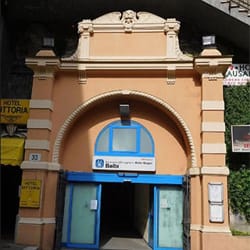One of such traditional recipes is today off the menu: the typical Ligurian recipe called frisceu di gianchetti (fish fritter) because the gianchetti in local dialect, or bianchetti in Italian, are juvenile fish or more specifically ‘baby’ sardines and anchovies and therefore their fishing has been prohibited by Law as the population of these fish was drastically diminishing in our seas.
These juvenile fish used to be fished out in large quantities and then fried in a batter.
A typical recipe from Liguria which requires skills is the cappon magro, a name which has always intrigued me because cappone in Italian means capon (rooster), but this recipe is indeed prepared with fish.
This recipe combines the products of the land (vegetables) with those of the sea (fish and seafood) in a combination where the harmony of flavors and colors reigns, creating what could be the symbol of our region, stretched between the mountains and the sea.
It is said that its recipe was created in ancient times, back when servants used to reuse leftovers from the nobles’ banquets. By reusing the leftovers of fish soups and adding vegetables they gave life to this dish. Its name could probably derive from the French chapon, a slice of toasted bread rubbed with garlic and used for soups or some say that the name could be cappon because it replaced the capon (rooster) during times of financial hardship. Back in ancient times in this region fish was indeed considered pheasant food (since it could be easily found in nature) whereas meats were reserved for the rich. Nowadays eating fish and seafood is much more expensive than eating meat and fish restaurants are considered fancy places for special occasions.

The cappon magro is a very colorful dish
The cappon magro is today considered the king of Ligurian fine food, a dish for celebrations, pre-Easter feasts and Christmas lunches.
Its preparation is long, not only because it involves the cooking of its – many – ingredients, but also because its ingredients are then beautifully stacked on top of one another like in a culinary game of Jenga! Cappon magro is a stack of fish and seafood of your choice, cauliflower, beetroot, artichokes (when in season, because Ligurian cuisine respects seasonal products), scorzonera burdock, celery, carrots, green beans, boiled potatoes, radish, breadcrumbs, mushrooms (when in season) and hardboiled eggs, all sprinkled with parsley, lemon juice, vinegar and olive oil.
As you can imagine, all ingredients are finely sliced or chopped or the result would be a mountain of food!
And since many Ligurian recipes have funny names, here is another one: brandacujùn, a real delicacy.
The brandacujùn is a typical dish of Ligurian origins prepared mainly with potatoes and stockfish (cured salted cod). It is common in particular on the western Ligurian coast and its recipe involves the use of cured cod, boiled potatoes, garlic, parsley, oil, olives, lemon juice, salt and black pepper.
Its preparation is unique because the ingredients are put in a container which is then shaken like in the preparation of a cocktail leading to the amalgamation of its ingredients (which must not, however, be completely smashed).

The brandacujùn is hard to make to perfection
And in Zena (Genoa in dialect), we cannot miss the delicious pansöti co-a sarsa de noxe or pansotti pasta with walnut sauce (from the Ligurian dialect pansa, belly), a stuffed pasta, similar to ravioli, from which they essentially differ in size and for the lack of meat in the filling. Pansotti are stuffed with herbs, ricotta cheese and spinach and then accompanied by a walnut sauce which should never be heated up (just like pesto sauce). The sauce is made with milk, crushed peeled walnuts, the soft inside of bread and nutmeg blended in a blender.
All these traditional recipes may seem somewhat weird but trust me: they are delicious!






























































